Bianculli here: Today's guest column, the latest from Tom Brinkmoeller, finds its inspiration from a travel series -- one that inspired Tom to interview the producer about why public television's
Rick Steves' Europeseemed so different from most other TV travel shows.
Read on to travel to Tom's full column...
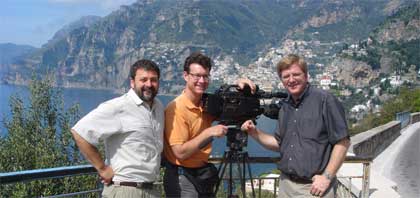
Ultimate Journeymen Make Up 'Team Steves'
Disclaimer: Even though this is the second time I recently have used this space to praise public television, you will not be hit up for a pledge or made to endure a showing of a Wayne Dyer or Suze Orman special. It is not my intention to put your wallet, your patience or your intelligence in jeopardy. -- T.B.
--
Travel shows, or "travelogues," as they used to call them in Jimmy Durante's day, are just about as old as photography itself. Whether professionally produced or a friend's home movies, people love to show off pictures of where they've been. The challenge to giving this work-horse genre some pedigree is to make the viewing as compelling as the photographer's perceived experience.
Nobody does this better than public television's Rick Steves, whose series have made world travel unintimidating and inviting, educational and entertaining -- and a bit addictive to wannabe travelers. As a viewer, one can guess at the reasons Rick Steves' Europe, which is seen in 95 percent of US markets, ranks so high in a relatively crowded category. For more accuracy, it's nice to be able to ask an insider.
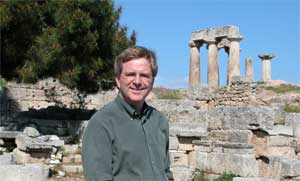
Producer Simon Griffith has been in on the making of more than 80 episodes over 10 seasons with Steves, and his insight takes away the guesswork. The guesses were pretty accurate: Each half hour is the result of extensive preparation, a well-crafted script, high production values, teamwork among talented people and more hard work than any project connected with the word "vacation" ought to contain.
All that, and an ethics policy that doesn't make the kind of "pay for play" deals that help many travel programs reduce costs by trading exposure in the programs for accommodations, travel, meals and favors. After a decade of filming, the team behind this series continues to avoid production shortcuts and formulas. Each episode connects and flows in a way most viewers feel they have a close-to-being-there impression of the destination visited.
Griffith shared the details of how they reach these goals. Each episode takes six "usually really long" days of morning-into-the-night shooting, says Griffith, part of the trio that puts the shows together. (He's the man with the beard often seen sharing a restaurant table with Steves; videographer Karel Bauer, who shoots those meal scenes, sits down at the third place setting, no doubt to cold food, once the scene is finished.)
Twice a year, the team makes a three-week production trip. These trips wear out even the show's host, whom Griffith calls "a genuine Viking" because of Steves' nonstop work ethic. One almost can get empathy fatigue hearing about the double-time marches Steves' small production crew makes during its European trips. Every day starts with an early working breakfast, in which the three review the script for the day and plan the next 12 or so hours of shots.
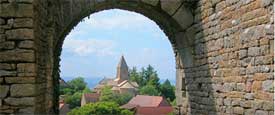
"We make sure we don't just shoot the nouns," Griffith says, which would result in "a video slide show" that emphasized little more than pointing a camera at each location. Steves' script is supplemented during a "meeting of the minds" that adds interlocking sequences of visuals giving the production a rich and polished look unique to travel shows.
This, by nature, eats up a lot of videotape -- "about 12 40-minute tapes per show," Griffith says. "We certainly have to do things again and again" until all the required elements fall into place.
"Occasionally, we'll have to do 20 to 25 takes before we get what we want," he says. "We can easily take 15 or 20 minutes to shoot a 20-second transition scene."

This can get tricky if the scene to be reshot is one in which Steves speaks to the camera as he drives. To make sure they get the proper lighting and background, the crew repeatedly will travel the same stretch of the road, "sometimes for a half hour or more," until the scene is perfect. Griffith says other drivers on that road don't always share the crew's enthusiasm for perfection.
Sometimes, when shooting in a very controlled venue, such as the Louvre or Prado museums, they are given limited access outside of the museum's normal hours. To add to the feel of what it is like during a normal visit, the crew will recruit guides, security guards and cleaners from their normal duties to stand in as tourists.
When daylight ends, often scenes will be shot of restaurant experiences, performances or downtown areas that better illustrate the script. Then, finally, the shooting ends.
While Griffith and Bauer often take that as a chance to unwind over a leisurely meal or drink in a relaxed cafe, Steves will go back to his room to work on his blog, communicate with his office, plan his weekly radio show or fine tune the next day's script.
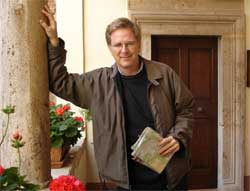
Steves' attitude about serving the people who turn to him for travel advice is characterized by a sentence in his recent blog entry: "You can read a book without flying to Rome. A walking tour (which costs triple the price of that book) should connect you vividly to the place."
"Rick is one of the hardest working persons I've ever met," says Griffith.
Once they have returned home, three to four weeks are spent editing editing each episode into finished form. That's 30 weeks of work to produce each six-episode season. (Think NBC spends five to six weeks on each episode of Howie Do It?)

Steves' enthusiasm for perfection seems to pay off. His Edmonds, WA, company, Europe through the Back Door, includes a full-service travel company, tour-book and video sales, Steves' weekly radio show, a very popular travel blog, as well as the TV series. If his blog reader reactions and the questions from radio callers are a barometer, Steves' enthusiasm for travel has to be contagious, and is reflected in sales figures.
But even if one may never be able to take actual vacations in Europe, each half hour's work by these perfectionist journeymen has to be the next-best thing. To find where and when Rick Steves' Europe is broadcast in your area, click HERE.
---------
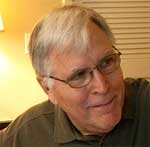
I, like Peter Sellers' Chauncey Gardner character in the film Being There, unapologetically "like to watch." My almost-a-geezer status gives me more time than ever to watch the lesser-hyped areas of television, where I often find some wonderful gems. Sharing those finds is even more fun than watching.